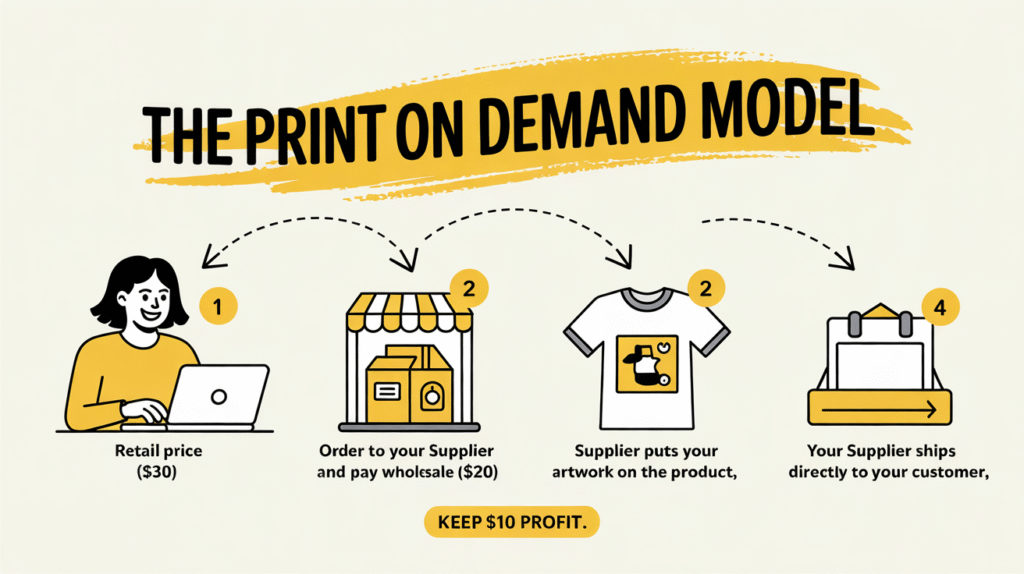Hey there! So you’re thinking about starting an online business? That’s awesome! I remember when I first got curious about making money online. It felt both exciting and a little overwhelming, right? But here’s the good news: you don’t need a huge budget or years of experience to get started. Some of the most successful online entrepreneurs began exactly where you are now.
Let me share some really solid online business ideas that you can actually start today. Not someday, not after you save up tons of money, but literally today. Ready? Let’s dive in!
1. Freelance Writing or Content Creation

If you enjoy writing, this could be perfect for you. Businesses are constantly looking for people who can write blog posts, website copy, social media content, you name it. The best part? You can start with what you already know. Love fitness? Write about that. Into tech? There’s your niche.
Here’s what makes freelance writing so great: you literally need nothing but a computer and internet connection to start. The demand is absolutely insane right now because every single business needs content to attract customers online. We’re talking blog posts, email newsletters, product descriptions, video scripts, LinkedIn posts, the list goes on and on.
You can start by creating profiles on platforms like Upwork, Fiverr, and Freelancer.com. I’d suggest beginning with lower rates just to build up some reviews and testimonials. Once you have 5-10 solid projects under your belt, you can start charging what you’re really worth. And trust me, good writers can charge anywhere from $50 to $500+ per article depending on length and complexity.
The cool thing is you can specialize over time. Maybe you discover you love writing about travel, or you’re really good at explaining technical stuff in simple terms. That specialization makes you more valuable and lets you charge premium rates. Some freelance writers I know are making six figures a year working from coffee shops around the world. Start by pitching to small businesses in your area or reaching out to online publications in topics you love.
2. Virtual Assistant Services
So many entrepreneurs and small business owners need help with everyday tasks like managing emails, scheduling appointments, or organizing their files. If you’re naturally organized and good at multitasking, you could be making money as a virtual assistant within days.
Think about it: successful entrepreneurs are usually juggling a million things. They need someone to handle the administrative stuff so they can focus on growing their business. That’s where you come in! As a VA, you might be doing things like responding to emails, booking travel arrangements, managing their calendar, doing data entry, creating presentations, handling customer service inquiries, or even managing their social media accounts.
The startup costs? Pretty much zero. You probably already have everything you need. The skills required aren’t rocket science either. If you’re decent with Google Suite or Microsoft Office, can communicate clearly, and are reliable, you’re already qualified. What matters most is being trustworthy and detail-oriented because people are literally trusting you with their business operations.
You can find VA work on sites like Belay, Time Etc, or Fancy Hands. Or go the independent route and reach out directly to entrepreneurs, coaches, real estate agents, or consultants who are growing their businesses. Many VAs start at around $15-25 per hour, but experienced VAs specializing in specific areas like Pinterest management or podcast production can charge $50-75+ per hour. Plus, many clients want ongoing relationships, so you get that sweet recurring income every month.
3. Online Tutoring or Coaching

Are you good at something? Like, really good? Whether it’s math, languages, guitar, or even life coaching, people will pay to learn from you. With platforms like Zoom making it super easy to connect face-to-face, you can teach students from anywhere in the world.
The online education market is absolutely exploding. Parents want their kids to excel in school, adults want to learn new languages or skills, and people everywhere are looking for coaches to help them with fitness, business, relationships, you name it. The beautiful thing is that you don’t need any fancy certifications for many types of tutoring or coaching. You just need to know more than the person you’re teaching and be able to explain things clearly.
For academic tutoring, platforms like Tutor.com, Wyzant, and Chegg Tutors connect you with students who need help. If you’re teaching English to international students, VIPKid and Cambly are popular options. The pay varies, but tutors typically make between $20-60 per hour depending on the subject and their experience.
If you’re more into coaching, the sky’s the limit. Life coaches, business coaches, fitness coaches, career coaches… there’s a market for helping people achieve their goals in pretty much any area. You can start by offering free or discounted sessions to get testimonials, then gradually raise your rates. Many coaches charge $100-300+ per session once they’re established. Create a simple website, be active on social media sharing valuable tips, and you’ll start attracting clients who resonate with your approach.
4. Dropshipping Store
Here’s a cool one: you can run an online store without ever touching the products. With dropshipping, you set up an online shop, customers order from you, and then a supplier ships the product directly to them. You handle the marketing and customer service while never worrying about inventory or shipping logistics.
Shopify makes setting this up really straightforward. You can literally have a store up and running in an afternoon. The key is finding the right products to sell. You want items that solve a problem, aren’t easily found in local stores, and have enough profit margin to make it worthwhile. Think trending gadgets, unique home decor, specialized fitness equipment, or products for specific hobbies.
You’ll use apps like Oberlo or Spocket to find suppliers, import products to your store, and automatically fulfill orders. When someone buys a product for $50 from your store, your supplier might charge you $25, and you keep the $25 difference. Of course, you’ll have advertising costs to consider, which is where Facebook ads, Instagram ads, or TikTok marketing come in.
The learning curve involves understanding how to market effectively and provide good customer service. You’ll need to test different products to see what resonates with your audience. Some dropshippers fail because they give up too soon, but others are making thousands of dollars a month once they find winning products. Start with a focused niche rather than trying to sell everything, do your research on what’s trending, and be prepared to invest some money in advertising to drive traffic to your store.
5. Print-on-Demand Business

Love design or have a knack for funny slogans? Print-on-demand lets you sell custom t-shirts, mugs, phone cases, posters, and more without holding any inventory. You create the designs, upload them to platforms like Printful, Redbubble, or Teespring, and they handle printing and shipping when someone buys.
This is seriously one of the lowest-risk businesses you can start. There are no upfront costs for inventory because products are only made after someone orders. You can test hundreds of designs without financial risk. The profit margins might be slimmer than traditional retail, but you’re not taking on any of the traditional retail risks either.
Your success really depends on your designs and marketing. If you’re not a designer yourself, you can hire designers on Fiverr for pretty cheap to create designs based on your ideas. Look at what’s trending on platforms like Etsy or Amazon Merch to get inspiration. Successful niches include funny quotes, designs for specific professions (nurses, teachers, dog groomers), hobby enthusiasts (hikers, gamers, knitters), and current events or trending topics.
You can sell through multiple platforms simultaneously. Set up a Redbubble shop for passive income where their audience finds you, create a Shopify store integrated with Printful for more control and branding, and maybe even sell on Amazon Merch. Some print-on-demand entrepreneurs are making full-time incomes just from this, especially once they figure out what designs their audience loves. The key is consistency. Upload new designs regularly, optimize your titles and tags for search, and promote your best sellers on social media.
6. Social Media Management
If you’re already spending time on Instagram, Facebook, or TikTok, why not get paid for it? Small businesses know they need to be on social media, but many owners don’t have the time or know-how. You can help them create content, schedule posts, engage with followers, and grow their presence.
Think about all the local businesses around you: restaurants, boutiques, salons, gyms, real estate agents, contractors. Most of them have social media accounts that are either completely neglected or just not being used effectively. That’s your opportunity! As a social media manager, you’d be creating a content calendar, designing graphics, writing captions, responding to comments and messages, running ads, and tracking analytics to show your client what’s working.
You don’t need a marketing degree to do this. You just need to understand the platforms, know what kind of content performs well, and be creative. Start by managing social media for free or cheap for a friend’s business or a nonprofit to build your portfolio. Document the results: follower growth, engagement rates, website traffic. Those case studies will help you land paying clients.
Many social media managers charge per platform per month. You might charge $300-500 per month to manage one platform for a small business, or $1000-2000+ per month for managing multiple platforms with more advanced strategies. Once you have 5-10 clients, you’ve got yourself a solid income. You can do this work from anywhere, often in just a few hours per day once you get into a rhythm with content batching and scheduling tools like Later, Buffer, or Hootsuite.
7. Affiliate Marketing

This one’s interesting because you’re essentially recommending products you love and earning a commission when people buy through your unique link. You could start a blog, YouTube channel, or even just use social media to share products in niches you’re passionate about.
The beauty of affiliate marketing is that you’re not creating products, handling customer service, or dealing with inventory. You’re simply connecting people with products that solve their problems. Every time someone clicks your special affiliate link and makes a purchase, you earn a percentage of that sale.
Amazon Associates is the easiest starting point because Amazon sells literally everything, but the commissions are relatively low, usually 1-10% depending on the product category. Higher commissions come from promoting software (like web hosting or email marketing tools), online courses, or specialized products. Some affiliate programs pay 30-50% recurring commissions, which means you get paid every single month as long as the customer keeps their subscription.
The key to success with affiliate marketing is building trust with an audience. You can’t just spam links everywhere. You need to provide real value, honest reviews, tutorials, comparisons, and genuinely helpful content. Start a YouTube channel reviewing tech products, create a blog about budget travel with links to booking sites and travel gear, or build an Instagram page about fitness with affiliate links to supplements and equipment.
It takes time to build up traffic and audience, so affiliate marketing is often better as a side hustle that grows into something bigger. But once it’s rolling, it can be incredibly passive. Some affiliate marketers make a few hundred extra dollars a month, while others are pulling in six or seven figures annually. The income potential really depends on your audience size and how well you convert them into buyers.
8. Online Course Creation
Got expertise in something specific? Package it into an online course! People are willing to pay good money to learn new skills, especially if you can teach them something that’ll help their career or personal life. The beautiful thing is you create it once and can sell it over and over.
The e-learning industry is worth billions, and it’s growing like crazy. People would rather pay $100-500 for a comprehensive course they can take at their own pace than spend thousands on traditional education or coaching. You could create a course on literally anything: how to use Excel like a pro, photography for beginners, starting a podcast, baking sourdough bread, digital marketing strategies, learning a language, the list is endless.
Platforms like Teachable, Thinkific, Udemy, or Kajabi make hosting and selling courses super easy. They handle the payment processing, video hosting, and give you a platform to build your course. Udemy takes a bigger cut of your sales but brings you students through their marketplace. Having your own course on Teachable or Kajabi means you keep more of the money but you’re responsible for marketing.
Creating a course does require upfront work. You need to plan your curriculum, record videos (your phone camera is fine to start), create any worksheets or resources, and set up your course platform. But once it’s done, it becomes a passive income stream. You can sell the same course to 10 people or 10,000 people without doing extra work. Successful course creators often make anywhere from a few thousand to hundreds of thousands of dollars. Promote your course through social media, guest appearances on podcasts, free webinars, or YouTube videos that showcase your expertise.
9. Graphic Design Services

If you have an eye for design, businesses need you. From logos to social media graphics to website designs, the demand is huge. And you don’t even need fancy expensive software anymore. Canva has made design accessible to everyone, though professionals often use Adobe Creative Suite.
Every business needs design work constantly. They need logos when they start, social media graphics every single week, flyers for events, business cards, email headers, website banners, product packaging, the list goes on forever. Even if you’re not a formally trained designer, if you understand basic design principles like color theory, typography, and composition, you can create professional-looking designs that businesses will happily pay for.
Start by creating a portfolio, even if it’s mock projects you create for imaginary clients. Design a logo for a fake coffee shop, create a social media template set, or redesign a website you think could look better. Show range in your portfolio so potential clients can see different styles and types of projects. Set up profiles on Fiverr, 99designs, or Upwork to find your first clients.
Pricing for design work varies wildly. On Fiverr, beginners might charge $25-50 for a basic logo, but experienced designers charge $500-5000+ for comprehensive branding packages. Social media graphic templates might go for $30-100, while full website designs can be $1000-10,000+. Once you establish yourself, you can move away from freelance platforms and work directly with clients for better rates. Many graphic designers eventually create passive income by selling templates on Creative Market or their own websites, so they’re earning money even while they sleep.
10. Subscription Box Service
Okay, this one takes a bit more planning, but hear me out. People love getting curated surprises in the mail. Whether it’s snacks from around the world, book recommendations, craft supplies, wellness products, or niche hobby items, subscription boxes are booming.
The subscription box model is brilliant because you get recurring revenue. Instead of constantly finding new customers, people pay you every single month. If you have 100 subscribers paying $30/month, that’s $3,000 in predictable monthly income. As you grow to 500 or 1000 subscribers, the numbers get really exciting.
The key is finding the right niche. What are you passionate about that other people would love too? Maybe you’re really into stationery and could curate beautiful notebooks, pens, and paper goods. Or you’re a coffee enthusiast who could send different specialty coffee beans with tasting notes. Pet owners love subscription boxes for their dogs or cats. Busy parents would appreciate age-appropriate activity kits for their kids.
You’ll need to source products, which means reaching out to wholesalers or manufacturers to get good pricing. You need the cost of goods to be low enough that you make a profit after paying for the products, box, packaging materials, and shipping. Start small, maybe with 10-20 boxes to friends and family to test your concept and work out the logistics. Use their feedback to improve before scaling up.
Marketing is crucial for subscription boxes. You’ll need a website with beautiful photography showing what’s in your boxes, social media presence sharing unboxing videos and customer reactions, and possibly partnerships with influencers in your niche. Platforms like Cratejoy can help you manage subscriptions and payments. The startup costs are higher than most ideas on this list because you’re dealing with physical products, but the recurring revenue model and passionate communities around subscription boxes make it potentially very profitable once you find your groove.
Time to Take Action
Look, I know starting something new can feel scary. You might be thinking, “But what if I fail?” or “What if I’m not good enough?” Trust me, everyone feels that way at first. The difference between people who succeed and people who don’t is simply that the successful ones started.
Pick one idea from this list that genuinely excites you. Not the one that sounds most profitable or impressive, but the one that makes you think, “Hey, I could actually see myself doing that.” Start small. Maybe just spend an hour today setting up a profile on a freelance platform, sketching out course ideas, or researching your first potential product.
The internet has created opportunities that our parents couldn’t even imagine. You can reach customers across the globe from your living room. You can start with little to no money. You can work around your current job or commitments. The barriers have never been lower.
The beautiful thing is, you don’t have to quit your day job tomorrow. Start this as a side hustle. Test the waters. Learn as you go. Maybe in six months or a year, your side hustle is making enough money that you can consider going full time. Or maybe it just becomes a nice stream of extra income that funds your vacations or helps you pay off debt. Either way, you’re better off than if you never started.
Remember, every expert was once a beginner. Every successful online business owner had a first client, a first sale, a first subscriber. They had moments of doubt and faced obstacles, but they kept going. You have access to the same tools, the same internet, the same opportunities they did. The only question is: will you take action?
So what are you waiting for? Your future self will thank you for starting today. Pick your idea, take that first small step, and remember that progress beats perfection every single time. You’ve got this!
Now go out there and make it happen. I’m rooting for you!


























































































